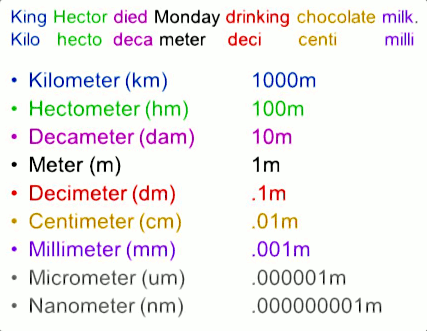Metric units of length
Distance measures length. In the metric system of measurement, the most common units of distance are millimeters, centimeters, meters, and kilometers. The centimetre ( SI symbol: cm) is a unit of length in the metric system equal to 10−2 metres ( 1 100 m = 0.01 m ). A meter is equal to approximately 39.37 inches in the British Imperial and United States Customary systems. The French originated the metric system of measurement (figures!) Meter is also spelled metre. The British, for example, use metre.
- A paper clip is about 1111 millimeter thick.
- A fingernail is about 1111 centimeter wide.
- The length of a guitar is about 1111 meter.
- A kilometer is equal to 1000100010001000 meters. It is a little over half of a mile.
1 mm is equal to 0.1 centimeters:
- 1 mm = 0.1 cm
The distance d in centimeters (cm) is equal to the distance d in millimeters (mm) divided by 10:
- d(cm) = d(mm) / 10
Convert 20 millimeters to centimeters:
- d(cm) = 20mm / 10 = 2cm
TABLE
The U.S. government definition of a foot is 0.3048 meters.
The meter was historically defined by the French Academy of Sciences in 1791 as 1/10,000,000 of the quadrant of the Earth’s circumference running from the North Pole through Paris to the equator. The International Bureau of Weights and Measures in 1889 established the international prototype meter as the distance between two lines on a standard bar of 90 percent platinum and 10 percent iridium. In 1960 the meter was thus defined in the SI system as equal to 1,650,763.73 wavelengths of the orange-red line in the spectrum of the krypton-86 atom in a vacuum. This replaces an actual physical reference of what a meter is. In 1983 a standard was established for the speed of light based on new technology accuracy of measurement as 299,792,458 meters per second. The meter is now thus defined as the distance traveled by light in a vacuum in 1/299,792,458 of a second.
